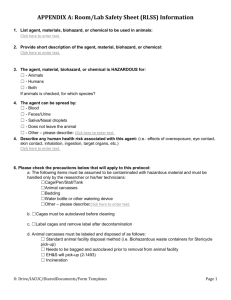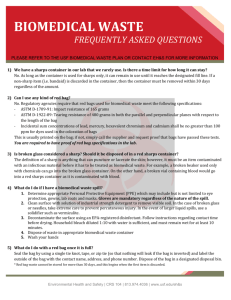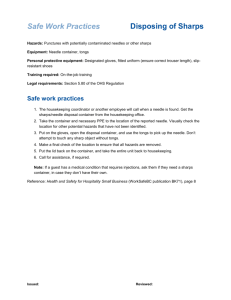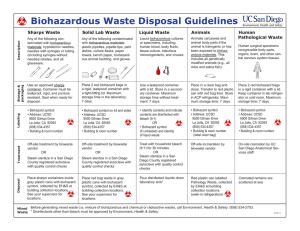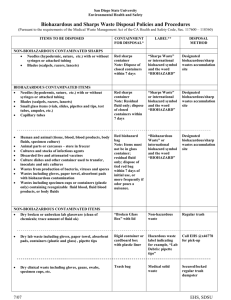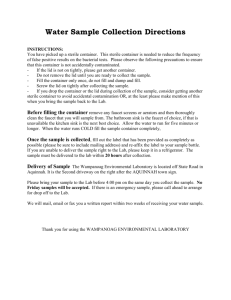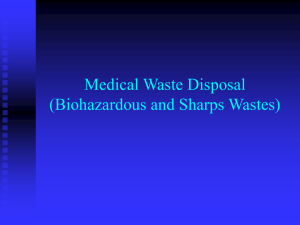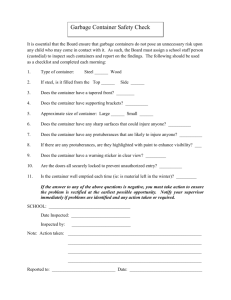Safety Chemical Storage
advertisement
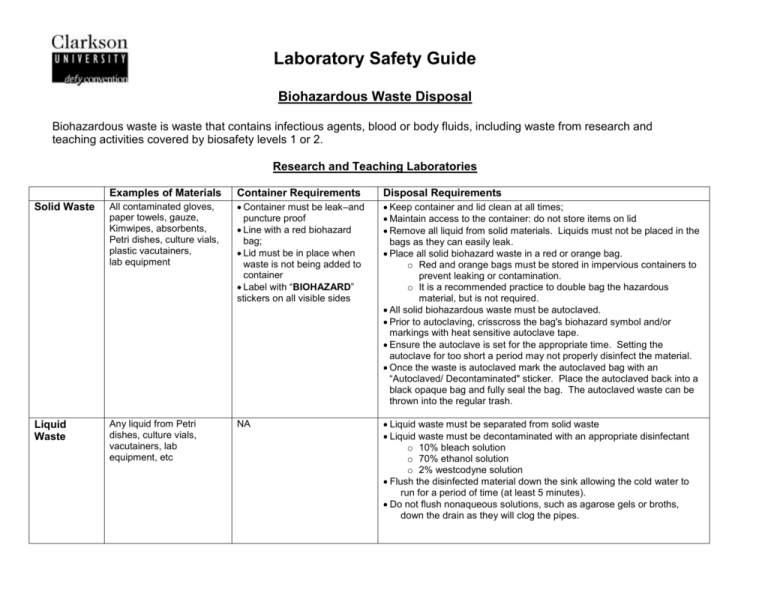
Laboratory Safety Guide Biohazardous Waste Disposal Biohazardous waste is waste that contains infectious agents, blood or body fluids, including waste from research and teaching activities covered by biosafety levels 1 or 2. Research and Teaching Laboratories Examples of Materials Container Requirements Disposal Requirements Solid Waste All contaminated gloves, paper towels, gauze, Kimwipes, absorbents, Petri dishes, culture vials, plastic vacutainers, lab equipment Container must be leak–and puncture proof Line with a red biohazard bag; Lid must be in place when waste is not being added to container Label with “BIOHAZARD” stickers on all visible sides Keep container and lid clean at all times; Maintain access to the container: do not store items on lid Remove all liquid from solid materials. Liquids must not be placed in the bags as they can easily leak. Place all solid biohazard waste in a red or orange bag. o Red and orange bags must be stored in impervious containers to prevent leaking or contamination. o It is a recommended practice to double bag the hazardous material, but is not required. All solid biohazardous waste must be autoclaved. Prior to autoclaving, crisscross the bag's biohazard symbol and/or markings with heat sensitive autoclave tape. Ensure the autoclave is set for the appropriate time. Setting the autoclave for too short a period may not properly disinfect the material. Once the waste is autoclaved mark the autoclaved bag with an “Autoclaved/ Decontaminated" sticker. Place the autoclaved back into a black opaque bag and fully seal the bag. The autoclaved waste can be thrown into the regular trash. Liquid Waste Any liquid from Petri dishes, culture vials, vacutainers, lab equipment, etc NA Liquid waste must be separated from solid waste Liquid waste must be decontaminated with an appropriate disinfectant o 10% bleach solution o 70% ethanol solution o 2% westcodyne solution Flush the disinfected material down the sink allowing the cold water to run for a period of time (at least 5 minutes). Do not flush nonaqueous solutions, such as agarose gels or broths, down the drain as they will clog the pipes. Laboratory Safety Guide Examples of Materials Container Requirements Disposal Requirements Sharps All needles, syringes, scalpels, razor blades, pipette tips, Pasteur pipettes, glass vacutainers, capillary tubes, slides and cover slips, contaminated broken glassware Container must be rigid, leakproof, and puncture-proof; Single use only; Keep baffle in place; Label with “BIOHAZARD SHARPS” sticker All sharps must be placed in appropriate sharps container. Once the container is ¾ full, close the top of the container. If the sharps are chemically contaminated, place a yellow Hazardous Waste label on the container and complete the label. Cross out the biohazard symbol on the container. Contact the Chemical Stockroom for a hazardous waste pickup. If the sharps are radioactive, cross out the biohazard symbol and place a radioactive material sticker on the container. Contact the Radiation Safety Officer to request a waste pickup. If the sharps are biohazardous or not contaminated, arrangements should be made with the Environmental Health & Safety Manager to have the waste transported to the Canton-Potsdam Hospital. Pathological Animal carcasses suspected to be or potentially infected; Container must be leak-proof and puncture-proof; Lid must be in place when waste is not being added to container Label with “BIOHAZARD” and “PATHOLOGICAL WASTE” stickers Waste must be placed in red or orange biohazard waste bags. If waste is chemically contaminated (ex: preserved in formaldehyde or other similar substance), place a yellow hazard waste sticker on the bag. Contact the Chemical Stockroom for a waste pickup. If waste is not chemically contaminated, arrangements should be made with the Environmental Health & Safety Manager to have the waste transported to the Canton-Potsdam Hospital. Recognizable human tissue, organs and body parts
